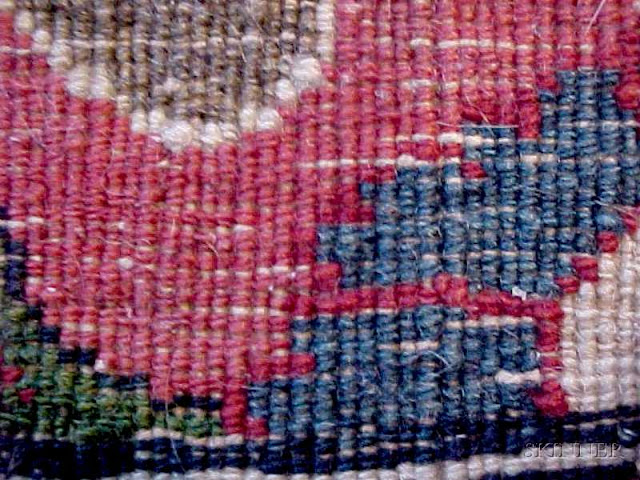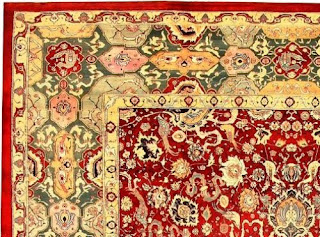This ius my Fiber Guide for Oriental Rug Professionals. If you spot some I missed or could say better please feel free to let me know and I can update this:
Cellulosic Fibers
Cellulose is wood, cotton, plant material.
Cotton
 |
| Wild Cotton |
Burns easily, does not self-extinguish and does not shrink from flame. The smoke is grey or white and smells like paper. The ash is grey and it powders easily. It does not bead or melt.
Hemp
Burns easily and does not self-extinguish, does not bead or melt, does not shrink from flame. The flame is bright and the smoke smells like burning wood or leaves. The ash is powdery.
Hemp is a fiber from the Cannabis plant’s outer skin of the hemp plant. Traditionally it is a retted fiber where the fiber is taken from the outer skin of the plant by letting it rot in slow moving water. Now it is often done mechanically using steam to separate the fibers.
Jute
Same as hemp - Jute is a fiber that comes from the Jute plant that grows primarily in India and Bangladesh. It is a retted fiber where the fiber is taken from the outer skin of the plant by letting it rot in slow moving water. It grows easily in poor soil without needing to be watered.
Linen (Flax)
Similar to hemp and jute but is harder to light and can be easily blown out. Linen is a fiber taken from the Flax plant. Man has used Linen for the last 8,000 years. It is a retted fiber and the fibers are removed from the plant by letting it rot. As the plant breaks down the pulpy mass is easy to separate from the linen fibers which retain their strength. (If you are ever testing an Antique rug and the warps and wefts is Linen or Hemp it could be an English copy of an Oriental Rug and could be very important.)
Rayon/Viscous
It smells like burning paper and leaves soft, gray ash. It does not normally bead but the chemicals it is sometimes treated with can bead.
Rayon was invented in 1855 by Georges Audemars a Frenchman. He developed it by treating wood pulp with solvents and taking the cellulose and extruding and spinning it. It was first used as Artificial Silk.
Acetate, Triacetate
Burns hot and quick and can flare up even after the flame is extinguished. It shrinks from flame and beads up into a hard bead that does not easily crush. It burns with a black toxic smoke and smells of hot vinegar or burning pepper.
Acetate is extruded and spun cellulose from purified wood pulp. It is similar to rayon but it is more heavily treated with chemicals.
Protein Fibers
Protein means that they are animal fibers
Silk and Wool
 |
| Silk Worms |
· Both are protein fibers.
· Both burn slowly and curl away from the flame. Wool burns hotter and sizzles. Wool has multiple beads and silk does one bead.
· Both melt into a hollow dark bead. Both crush easily but with silk the bead crushes to fine powder but wool crushes to gritty powder.
· Both smell like burning hair. But silk smells more like burnt meat and wool smells like burning feathers. Wool’s odor is more acrid.
· Silk is one long continuous fiber and wool is many fibers twisted together.
· Silk Burned Silk Is a protein fiber which burns slowly and curls away from the flame. It leaves dark bead which can be easily crushed. It is self-extinguishing and leaves ash that is dark, gritty, fine powder. It smells like burned hair or charred meat. It gives out a little or no smoke and the fume has no hazard.
 |
A Baluchi Breed Sheep
\ |
Wool - Is a protein fiber which burns slowly. It sizzles and curls away from flame and may curl back. It leaves beads that are brittle, dark, and easily crushed. It is self-extinguishing and leaves harsh ash from crushed bead. It gives out a strong odor of burning hair or feathers. It gives out dark smoke and moderate fume.
Chlorox test:
Protein fibers will completely disolve if left in a Clorox Bleach (5% Sodium hypochlorite). Silk takes 20 minutes to disolve.
The Touch Test
Wool, Cotton, and most fibers feel room temperature when you touch then but Silk feels cool to touch.
Man-made Petroleum Based Fibers
Nylon, Polyamide
Shrinks from flame and melts. It leaves a grey bead that is very hard. Caution should be used since Nylon drips and if it gets on skin it is hard to remove before a severe burn. It leaves no ash and the smoke is toxic.
Nylon is a petroleum based fiber invented February 28, 1935, by Wallace Carothers a scientist at DuPont's research facility in Wilmington Delaware.
Polyester
Burns quickly and shrinks away from flame, may also flare up. It leaves hard, dark, and round beads. After the flame, it burns slowly and is not always self-extinguishing. It has a slightly sweet chemical odor. It leaves no ash but its black smoke and fume are hazardous.
Polyester Is a polymer produced from coal, air, water, and petroleum products. Two British chemists, John Rex Whinfield and James Tennant Dickson invented Polyester in 1941 while working at Calico Printer's Association of Manchester.
Acrylic, also Modacrylic and Polyacrylic
Acrylic melts and curls away from heat. It is not usually self-extinguishing and melts and burns into a hard but brittle black bead with white smoke with a chemical smell. Modacrylic or modified acrylic is made in one long strand and then is chopped into shorter lengths and spun like wool. Modacrylic is self-extinguishing when the flame is removed.
Acrylic, also Modacrylic and Polyacrylic, are branded as Dralon, Montefibre, Fisipe, Acrilan (Monsanto), Creslan (American Cyanamid), and Orlon (DuPont).
Spandex
Melts but does not pull away from flame. It melts and burns even when the flame is removed and burns to a soft black ash. Burning Spandex gives off a chemical smell. Spandex is a Urethane based fiber but I do not know how exactly to categorize it so I put it in with the petroleum based fibers.
Some people in the business have asked why would I include Spandex in a Fiber Guide for Oriental Rug professionals. It is because I have seen recycled Spandex used in Afghan rug warps.





.jpg)
















